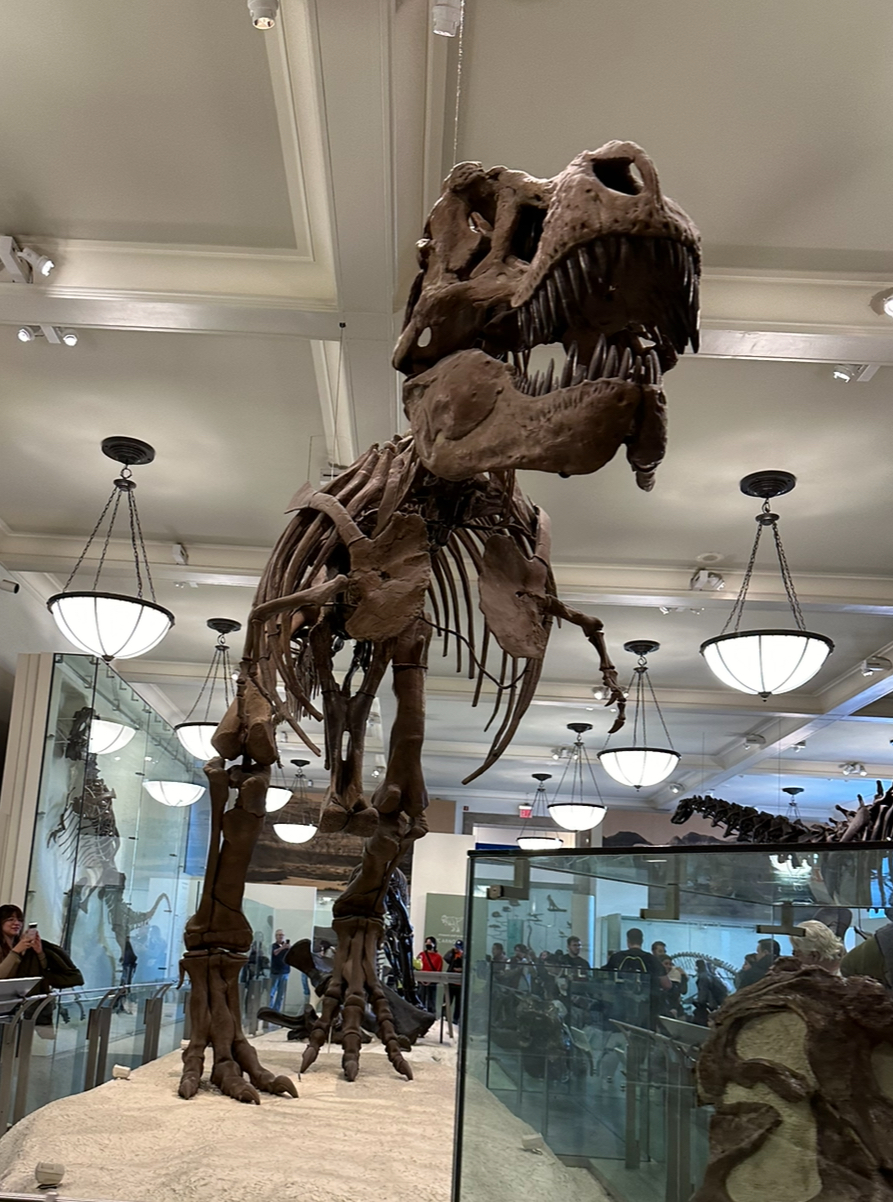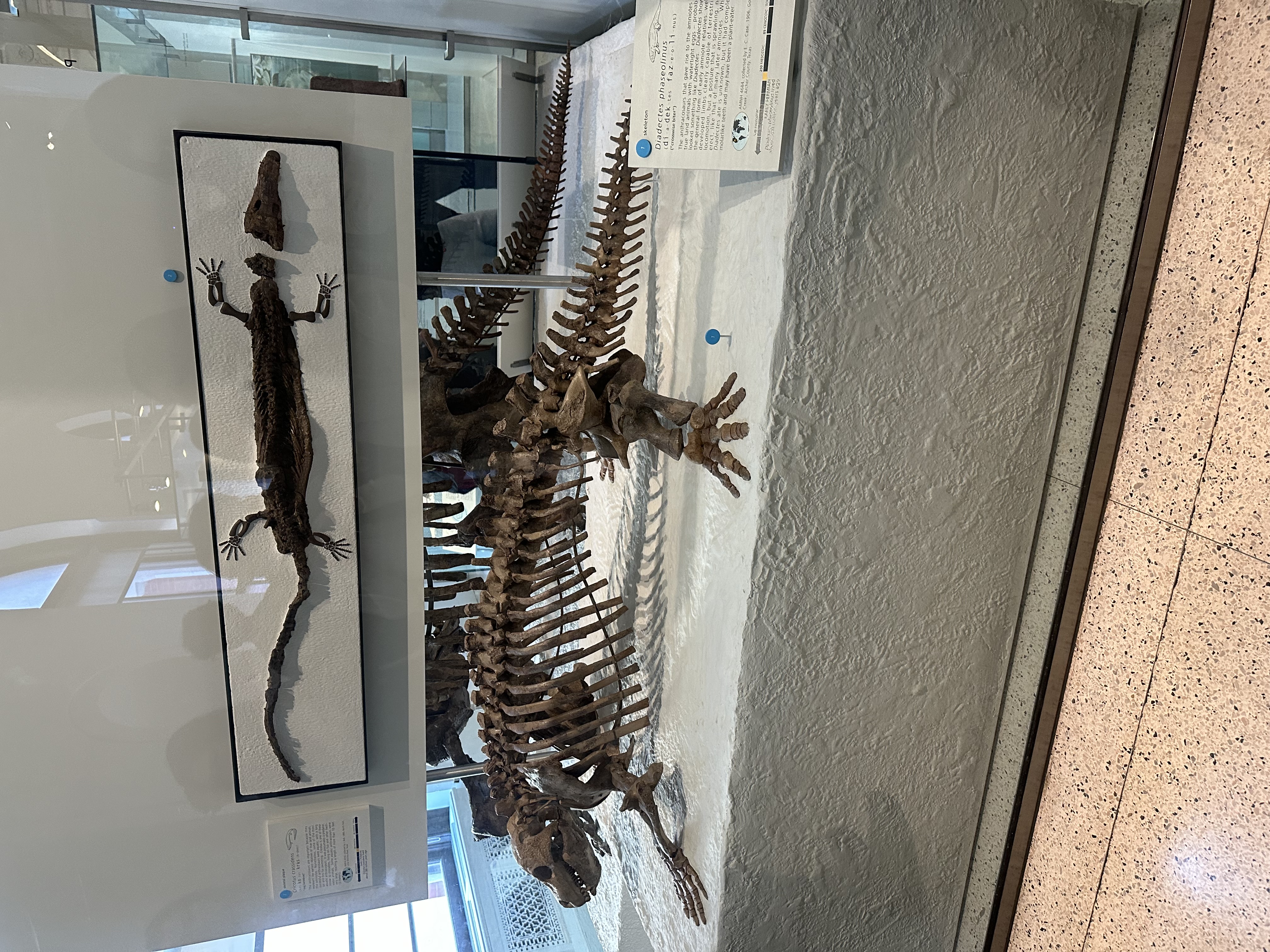New York City Excursion: American Museum of Natural History
American Museum of Natural History, 11/11/23:

Figure 1: Carnosaur display
typcial displays present in museums by reconstructing the dinosaurs with dug-up fossils and a mix of recreated fossils (either those not able to be preserved or shipped as examples to other museums) and put behind display cases. These reconstructions show in a three dimensional manner the average size of the dinosaur while also being able to showcase the particular developments in the dinosaurs compared to those before it. However, while the displays were very intricate, some--as acknowledged by Holtz-- were misinformed. One example was a skull from the 1990s in which was identified wrong as well as the recreation of the carnosaur created in the 1910s which had incorrect construction of its legs. The skull is an easy fix within the museum as it is simply rewording the display while the reconstruction would be very difficult as it would require the entire display to be dismantled and a new piece to be made to correct the shape of the leg. In general, every other display contained an interactive screen that people could click on which contained a family tree showing the developments and branching out of acquired traits from the original dinosaur to exhibit the trait. Additionally, there was a display in which a Pachycephalosaurus skull cap model was shown for the purpose of being able to touch. Overall, the interactive components (tree simulators with information) were accurate at portraying detailed information that was easy to understand and become educated on the origins of each particular trait. Due to the intricate details of each traits family tree, I believe this exhibit was aimed towards an audience that is late middle school to early high school or older seeing as this is around the education level in which students begin to learn about evolution and family trees, especially those that do not directly pertain to families in the sense of human lineage. Additionally, the lack of hands-on interaction within the exhibit and detailed explanations of each fossil clues that the hall may be aimed towards a more mature audience rather than a younger one.
I next explored the Hall of Planet Earth for my individual exploration in the museum. This exhibit capitalized on the effects of the natural earth on other species. Additionally, it covered the opposite effect, and how human influence has shaped our current topography and makeup of the earth. Specifically, there were examples of the elements present in common natural resources and how that affects the earth when intentionally used (or not) as well as temperature. The hall included hands-on examples of different rock formations and compounds, specifically those that have become radioactive and caused other issues explaining how natural resources and causes have led to temperature change in the world in addition to adding to the change in topography due to things such as landslides, flooding, and more. Additionally, there was a projection on the ceiling representing the temperature change across the world over a period of time to show how human affect as well as other factors have caused the globe to heat over time. I believe this particular hall is geared towards a younger audience such as around the age of elementary school. Due to the large presence of different types of interactive components such as visuals, hands-on pieces of rock, in addition to drawings that represent changes, the variety of models suggests a good way to keep the attention of those with shorter attention spans, such as younger kids. Despite having multiple versions of visual aids dispersed throughout the exhibit, the interactive components help to further explain the effects observed by scientists to those walking through by giving alternate versions of measurement for those who may not comprehend the intensity behind the numbers provided. For example, on a magnified globe hung on the wall, the museum portrayed not only the statistics of temperatures rising, but showed on the globe where CO 2 levels have increased and affected the temperature in areas over each respective continent. Seeing as this was a self-guided tour, neither I nor the people I was exploring with recognized any pieces of information that were incorrect.
Figure 2: Diadectes phaseolinus

Lastly, for the end of my time at the American Museum of Natural History, I followed Merck through the Hall of Vertebrate Origins. Merck concentrated on the chronological development of evolution within organisms specifically pertaining to their bone structure and how they lead to modern reptiles and mammals. The hall was organized to be followed chronologically as the species added on newly developed traits per display, starting with the development of the jaw. Some things Merck covered was the initial development of the jaw which established predators within marine organisms (although developed separately from the brain case). We then continued through the exhibit walking along the path as these early soon-to-be reptiles and mammals developed important bone structures such as ribs, on to protruding arms and legs, and then eventually individually functioning fingers and toes which extended off of those. These bone structures continue to develop up until the end of our tour where we viewed the anthracosaurs which was explained to be the being in which branched two types of animals: mammals and reptiles. In the presentation, Merck specifically connected how the bone structures shown to be growing throughout the evolution of these organisms led to their current functions. For example, having shorter legs and a more stout stature like the Diadectes phaseolinus (2) made for slower organisms which were likely herbivores while those with longer limbs were built to be fast, such that those possibly with dangerous features such as sharp teeth or claws were likely carnivores who were predators seeking to catch moving prey. Additionally, the development of watertight egg was a big connection found starting with amniotes, which are used as means of reproduction within modern turtles and lizards. Mainly the hall diplayed such evolutions through reconstructions of organisms either behind displays, by fossils that have been dug up,or hanging reconstructions along with accompanying plaques describing what is happening and an occasional pillar highlighting a major advancement in the beings' evolution. While the hall has many intriguing reconstructions, there leaves little room for any interactive components,however I believe the museum could incorporate little touch screens on or next to the display cases with mini quizzes for the viewers to guess what changes or has evolved per display case. Overall, despite there being a lack of interactive components within this exhibit, the many plaques and information pillars were very helpful in conveying and highlighting the important information in each section of the hall, none of which was pointed out to be outdated or incorrect. Despite a lack of interactive material in this hall, I believe this exhibit could still be aimed at a younger audience while still captivating the attention of an older one. Due to following the basic concept of evolution, especially when presented in a step by step manner as the Hall of Vertebrate Origins does, younger people can follow this exhibit with ease. Aditionally, for very young kids, due to the amount of visuals in the hall, they can keep themselves entertained by simply looking into all of the display cases while more mature viewers may keep themselves intrigued by reading the brief plaques on the displays.


